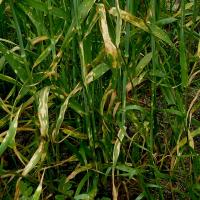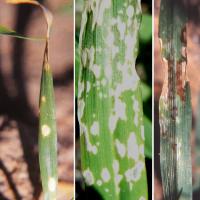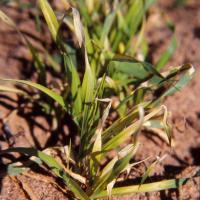Herbicides in this category include:
- Bromoxynil and carfentrazone that are used for post-emergent broadleaf weed control in cereals. These chemicals cause mild symptoms such as necrotic (tissue death) leaf spots and streaks.
- Non-selective knockdown herbicides that cause symptoms ranging from leaf streak and spotting, to death depending on rate, coverage and plant age.
-
Symptoms appear within hours (Group L), or one or two days (Group G, bromoxynil) of application.
| Chemical name | Example trade name | Chemical name | Example trade name |
|---|---|---|---|
| Group L - Bipyridyls | Group G - Aryl triazalinone | ||
| Diquat | Reglone | Cafentrazone | Affinity®, Hammer® |
| Paraquat | Gramoxone® | Group G - Pyrimadindione | |
| Diquat+paraquat | Spray Seed® | Butafenacil | Knockdown component of Logran ® B-Power® |
| Group C - Nitrile | Group G - Diphenyl ethers | ||
| Bromoxynil | Buctril® | Oxyfluorfen | Goal® |







